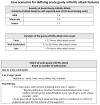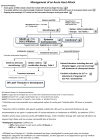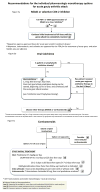2012 American College of Rheumatology guidelines for management of gout. Part 2: therapy and antiinflammatory prophylaxis of acute gouty arthritis
- PMID: 23024029
- PMCID: PMC3662546
- DOI: 10.1002/acr.21773
2012 American College of Rheumatology guidelines for management of gout. Part 2: therapy and antiinflammatory prophylaxis of acute gouty arthritis
Conflict of interest statement
Author conflict of interests are provided directly from the American College of Rheumatology and detailed separately.
Figures





Comment in
-
Update in rheumatology: evidence published in 2012.Ann Intern Med. 2013 Jun 18;158(12):903-6. doi: 10.7326/0003-4819-158-12-201306180-00107. Ann Intern Med. 2013. PMID: 23580081 No abstract available.
References
-
- Ahern MJ, Reid C, Gordon TP, McCredie M, Brooks PM, Jones M. Does colchicine work? The results of the first controlled study in acute gout. Aust N Z J Med. 1987;17:301–4. - PubMed
-
- Paulus HE, Schlosstein LH, Godfrey RG, Klinenberg JR, Bluestone R. Prophylactic colchicine therapy of intercritical gout. A placebo-controlled study of probenecid-treated patients. Arthritis Rheum. 1974;17:609–14. - PubMed
-
- Brook RA, Forsythe A, Smeeding JE, Edwards NL. Chronic gout: epidemiology, disease progression, treatment and disease burden. Curr Med Res Opin. 2010;26:2813–21. - PubMed
-
- Edwards NL, Sundy JS, Forsythe A, Blume S, Pan F, Becker MA. Work productivity loss due to flares in patients with chronic gout refractory to conventional therapy. J Med Econ. 2011;14:10–5. - PubMed
Publication types
MeSH terms
Substances
Grants and funding
LinkOut - more resources
Full Text Sources
Other Literature Sources
Medical

